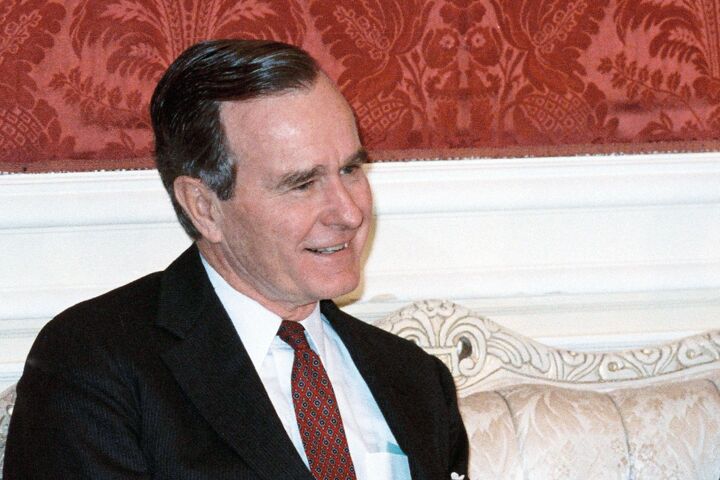
George Bush Greets Herbert W. Armstrong at Kennedy Center
“There is perhaps no other musical ensemble more consistently and closely associated with the history and tradition of European classical music than the Vienna Philharmonic,” boasts the orchestra’s website.
For over a century and a half the Vienna Philharmonic has been regaled by plaudits of notable admirers from Wagner to Bruckner, Brahms, Mahler and Strauss. Audiences from around the world have enjoyed inspiring performances, whether in their native Austria, or at world capitals visited by the famed ensemble.
Twenty-eight years ago in Pasadena, California, the Vienna Philharmonic Orchestra performed live on the stage of Ambassador Auditorium from February 18 to 19, 1984.
The following week, Herbert W. Armstrong flew to Washington, D.C., to watch their performance for the nation’s political elite in the national capital.
On March 12, 1984, the Worldwide News reported, “The Ambassador Foundation was instrumental in making the orchestra’s U.S. tour possible. Before the Washington concert, the foundation sponsored a reception at the Kennedy Center under the patronage of the Austrian Embassy.”
Upon arrival in D.C., on the occasion of the 1984 concert, Mr. Armstrong was ushered into the Israeli Room for a half-hour reception with about 20 guests including the chairman of the Kennedy Center, a U.S. senator, Washington Performing Arts representatives and embassy staff.
Some years earlier, Mr. Armstrong had hired an influential employee of the Kennedy Center to fill the post of director of performing arts for the Ambassador International Cultural Foundation, which ensured strong links between both parties.
As the performance of the orchestra drew near, Mr. Armstrong was ushered to his seat in the Austrian box, which was next to the U.S. presidential box reserved for President Ronald Reagan. However, on this occasion, it was occupied by Vice President George Bush, Secretary of State George Schultz, Austrian President Kirchschlaeger and Ambassador Thomas Klestil.
During the intermission, Mr. Armstrong “talked with Vice President Bush, Secretary Schultz, President Kirchschlaeger and Ambassador Klestil” (ibid).
One topic of conversation was Mr. Armstrong’s world travels, and it was during this discussion that Mr. Kirchschlaeger extended a personal invitation to Mr. Armstrong to visit him at the Presidential Palace in Vienna.
As the conversation closed and the ensemble reconvened for the second half of the performance, Mr. Armstrong noted that “he was impressed with the vice president’s abilities” (ibid). Mr. Bush had originally challenged Mr. Reagan for the Republican nomination, and upon defeat was selected as vice president for two terms. He would later succeed Mr. Reagan and become the 41st president, in office from 1989 to 1993.
As the orchestra resumed their performance, the group was able to compare it to the one the week previous at Ambassador. The consensus was that the acoustics of the Kennedy Center were exceptional and that the “quality and intimacy” of Ambassador Auditorium was without comparison.
After a wonderful performance, gracious applause and the drawing of the curtain, Mr. Armstrong was ushered to the top floor of the center for a special reception for around 300 guests.
“Mr. Armstrong was introduced to prominent individuals in the nation’s capital who thanked him for his involvement in the performing arts. Many commented on his World Tomorrow programs and about his Wall Street Journal advertisements” (ibid).
As the clock struck midnight, Mr. Armstrong departed to his hotel for some needed rest in advance of a meeting the following day at the Chinese Embassy.
Today, Mr. Bush is part of the great American audience witnessing the prevailing symphony of national division in the country he once led as president. A political dirge today encompasses a country facing imminent bankruptcy with its collective moral character in deep crisis.
As presidential election preparations swing into high gear, the U.S. searches for a way out of its deepening malaise amid accelerating cultural, ethical, military, moral and spiritual decline.
Perhaps in the quieter moments of retirement, whether at home in Texas, or maybe at the presidential library in College Station, Mr. Bush occasionally recalls that special evening in 1984 at the nation’s capital during which he was honored to meet the “internationally recognized ambassador for world peace,” Herbert W. Armstrong.
Just hours from the 41st president’s home is the successor to Ambassador Auditorium. Located north of Oklahoma City in Edmond, Armstrong Auditorium is the country’s newest hall for performing arts.
Should President Bush visit, he will find Armstrong International Cultural Foundation founder and chairman Gerald Flurry has followed in Mr. Armstrong’s footsteps, having taken the time to review the exterior, interior and acoustical blueprints of Ambassador Auditorium to use that design as a model for construction of its $25 million successor, Armstrong Auditorium.
Increasingly, performers from around the globe are gracing its stage and enjoying the peaceful environs and one-of-a-kind hospitality. This “polished jewel lifting the human spirit” is adorned with Swarovski-trimmed crystal chandeliers, Baccarat crystal candelabra, American cherry wood veneers, Spanish marble and Azerbaijani onyx. The hall’s superb internal acoustics and the soaring Swans in Flight sculpture, designed by Sir David Wynn, combine to set Armstrong Auditorium apart in a class all of its own.
Whether concert goer, cultural buff, or admirer of humanitarianism, we encourage you to visit this performing arts jewel at the heart of the United States.
